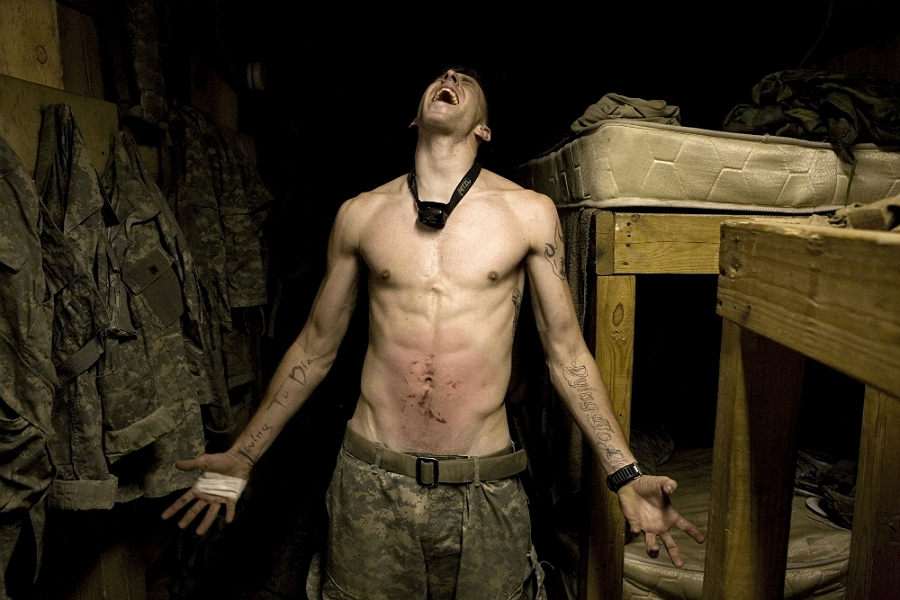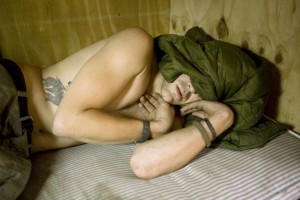Tim Hetherington:
You Never See Them Like This

A new exhibition of combat photographer Tim Hetherington’s work poses questions about our relationship with warfare. C James Fagan investigates…
It’s odd to think that, indirectly, war has formed part of my life; I’m incredibly grateful that I’ve never been involved in any form of conflict, though I suspect that I formed part of the last generation to be brought up fighting the Second World War by proxy.
Like many others we replayed, in very board terms, the war against the Axis; the playground becoming our battlefields. It also seemed to be played out again and again in repeats of war films. With hindsight it seems odd to extend such terrible times beyond their actual existence but I guess it was part of the country’s coming to terms with what happened and how it changed the world.
As an accompaniment to these apparently fictional wars of childish morality, there was a reflection of these battles on news broadcasts. Across my lifetime the television has shown me images from the Falklands, Bosnia, Iraq… twice; various images of men and machines in combat, which were then adapted and adopted by film makers and the like creating a strange feedback loop where it’s natural to confuse real and unreal images of war.
Little wonder then that the philosopher Jean Baudrillard stated that the Gulf War never happened. Part of Baudrillard’s argument was that the constant broadcasting of the first Gulf War (before the onset of 24 hour news, the ITV replaced their late night schedule with rolling coverage from Iraq) turned the mainly Western viewers into spectators, thus creating a great distance between the viewer and the notion of real conflict.
With these issues regarding the recording (and subsequent relaying) of conflict, it would seem that the role of a combat photographer becomes even more difficult: can you find a voice that says something different to all of the pre-existing reportage, films, TV and books? This is a question that Tim Hetherington (subject of a new exhibition at the Open Eye Gallery) attempted to address in his work by exploring his fascination with war, and through this, exploring notions of masculinity, which seem still to be entwined with the need to fight, to defend.

It was while with the 2nd Platoon of the 53rd US Infantry in the Korengal Valley, Afghanistan, that Hetherington turned his lens from the activities of the soldiers to the actual soldiers themselves. Entering into an intimate space, into the gaps between conflict where they were neither ‘active’ nor totally free from combat responsibilities.
It has been pointed out that war is 99% boredom and 1% terror and Hetherington’s photos bear this out. In those gaps between fighting the soldiers appear to fill their time with a strange form of juvenilia. Like teenage boys they’re playing computer games and casually looking at pornography. The plywood walls of their bunks and their own skin are adorned with sadistic images of guns, skulls and nihilistic mottos.
This in-part reinforces the idea of the ‘Gung-Ho’ spirit of the US military typified by films like Battle: Los Angeles. This may not seem very different than other images of combatants we’ve been used to since the Vietnam War; the difference comes with Hetherington’s choice to photograph the soldiers at rest and as they slept.
In the exhibition interpretation Hetherington is quoted as saying the soldiers look like ‘little boys [as] their mothers probably remember them’. It would seem that these are pubescent boys caught in a vacuum between childhood and adulthood, that the environment of the army provides a world which directly continues from the playground.
These images of sleeping soldiers also carry another meaning, and the ones that are intercut with footage of them out in the field in the near hallucinogenic installation ‘Sleeping Soldiers’ . That other meaning carried by these images is, of course, the possibility of death. The images of these sleeping warriors seem to echo some memory of Baroque paintings of martyred saints. These images serve to remind us that to be a soldier is to risk your life.
This sense of mortality throws Hetherington’s questioning of why men are drawn to war into stark contrast. Possibly any notion of mortality is something which is distant from the minds of the people entering combat zones; maybe this also applies to those who record conflict, but the sense of mortality is further compounded by Hetherington’s own death while recording the recent conflict in Libya.
His fate leaves us with a heritage of images attempting to go beyond an idea of ‘War is Hell’-style reportage thus attempting to initiate a dialogue about the reasons and motivations behind conflict and the nature of masculinity.
This remains an open dialogue, one awaiting a new voice.
C James Fagan
Images @ Tim Hetherington / Magnum Photos





